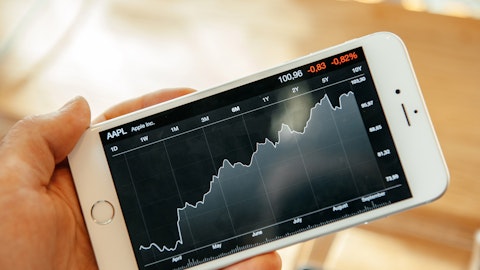Qualcomm’s Dividend Safety Score is 95, which indicates that the dividend is extremely safe and actually one of the safest in the entire market. The great score is driven by a reasonable payout ratio, solid cash generation, a healthy balance sheet, and stable returns on invested capital.
Currently, analysts expect EPS to be $3.76 for Fiscal Year 2016, and we expect the company to pay out about $2.02 per share in dividends this fiscal year. This implies a payout ratio of about 54%, which is in line with 2015 levels, but above historical levels.

Source: Simply Safe Dividends

Source: Simply Safe Dividends
The company has been a great cash generator over time with positive free cash flow every single year over the last decade.
The company is not capital intensive as they spend only about a billion dollar per year on capital expenditures (~4% of revenue), but is very R&D intensive where they spend around $5.5 billion dollars per year. Overall, we feel comfortable that the company should continue to generate adequate cash to fund the dividend in the near-to-medium term.

Source: Simply Safe Dividends
QUALCOMM, Inc. (NASDAQ:QCOM) also has a fantastic balance sheet. As of the end of the June quarter, they had $5.9B in cash, $11.2B in short-term marketable securities, and $13.9B in long-term marketable securities.
The marketable securities are mostly corporate bonds and mortgage- and asset-backed and auction rate securities. This liquidity position is offset by short-term debt of $1.7 billion and long-term debt of $10 billion. Overall, Qualcomm has a net cash position of roughly $19.3 billion, which provides the business with meaningful flexibility.
For fiscal year 2016, we expect Qualcomm to pay out roughly $3 billion in dividends. This means that the company can easily maintain the current dividend just based off the liquidity on the balance sheet alone. In fact, the company can maintain the current dividend for nearly 6.5 years just based on the net cash on the balance sheet.

Source: Simply Safe Dividends
While it’s true that the majority of the cash and marketable securities are held offshore ($28.6 billion of the $31 billion total), the company should be able to maintain ample liquidity in the U.S. to fund the dividend even in a stressful economic environment.
The historical economics of the business are quite favorable as well. Over the past decade, Qualcomm has generated a relatively stable operating profile with a trough operating margin in the mid-20% range and a peak over a bit over 40%.

Source: Simply Safe Dividends
This has also led to a stable return on invested capital profile over the past decade as well. Needless to say, the lack of volatility in the business economics allows the company to continue to be a very safe dividend payer, even if it experiences a gradual decline in royalty rates.

Source: Simply Safe Dividends
Taking everything into account, we consider Qualcomm’s dividend to be very safe based on the company’s reasonable payout ratio, solid cash flow generation, large liquidity position on the balance sheet, and historically stable business economics. While the future is uncertain in many ways for Qualcomm, the dividend should continue to be safe for the foreseeable future.
Dividend Growth Analysis
Our Growth Score answers the question, “How fast is the dividend likely to grow?” It considers many of the same fundamental factors as the Safety Score but places more weight on growth-centric metrics like sales and earnings growth and payout ratios. Scores of 50 are average, 75 or higher is very good, and 25 or lower is considered weak.
Qualcomm’s Dividend Growth Score is 82, which indicates that the dividend has very good growth potential.
The company initiated its quarterly dividend in early 2003 at $0.025 per share and has increased it ever since, making it a member of the dividend achievers list. Over the last 10 years, Qualcomm has grown its dividend by 18.5% per year.
Dividend growth has been even better over the last five years, averaging an annual increase of 20.2%.

Source: Simply Safe Dividends
However, given the issues discussed in the Key Risks section above, we expect dividend growth to be more moderate going forward.
Here is the CEO, Steve Mollenkopf, on the fiscal year second quarter earnings call (3) where they announced a 10% dividend increase.
“We also announced a 10% increase in our quarterly cash dividend, reflecting our confidence in the strength of our ongoing cash flows and future earnings growth.”
Looking into the areas where Qualcomm can increase its dividend, it likely has to come from earnings growth.
The payout ratio is already pushing the upper end of where it has been historically at over 50% and above other technology firms such as Microsoft (normalized payout ratio in the 40% range) and IBM (30% range) and above a more pure play competitor in Broadcom (30% range).
While the company can grow the dividend in the near term by using its significant liquidity position, eventually dividend growth will have to come from earnings and cash flow growth.
In the near term the company is likely to maintain around a 10% dividend growth rate, but the business faces some real challenges that can have a large impact on sales and EPS growth. Therefore, it’s more challenging to forecast dividend growth over a longer period of time.
Valuation
QUALCOMM, Inc. (NASDAQ:QCOM) currently trades around 16.5x 2016 earnings estimates and offers a dividend yield of 3.4%, which is meaningfully higher than its five-year average yield of 2.1% and reasonable income for conservative dividend investors.
Management needs to execute on their strategy of lowering the cost structure while still investing in research and development for technology on 4G/5G mobile phones and other applications.
If this occurs, it should lead to sales growth over the medium term with margin expansion. However, there are large unknowns on how much intellectual property they can create for next generation technologies and the royalty rates they will earn on that intellectual property.
As a result, we are unsure what the future economics of the business and can’t forecast a normalized earnings growth rate with much certainty.
However, if Qualcomm were to squeeze out low-single digits earnings growth (essentially in line with GDP growth), the stock appears to offer annual total return potential of 5-7%.
Conclusion
Qualcomm has dominant positions with intellectual property that is used in current and legacy communication technologies.
Typically these are the characteristics we like to see when looking at blue-chip dividend stocks.
However, the company is facing challenges in positioning themselves on next generation technology and declining royalties they earn for their intellectual property on these technologies.
With that said, the current dividend appears to be very safe as it is supported by a solid balance sheet with a significant liquidity position and the company’s internal cash flow generation.
Expectations are not low with the current valuation at around 16.5x 2016 earnings estimates. It appears to incorporate much of the expected growth in mobile shipments over the coming years.
While there is a lot to like about Qualcomm’s business, including favorable secular trends, a very high margin licensing/royalty business, and a solid balance sheet, the nature of the technology, competitive environment, and uncertainty over royalty rates creates enough uncertainty to keep it out of our Conservative Retirees dividend portfolio.
Additional Links:
(1) http://investor.qualcomm.com/dividends.cfm
(2) http://www.wsj.com/articles/qualcomms-main-profit-driver-is-under-pressure-1428967051
(3) http://seekingalpha.com/article/3966779-qualcomm-qcom-steven-m-mollenkopf-q2-2016-results-earnings-call-transcript?part=single





